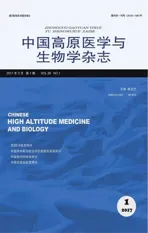Journal of High Altitude Medicine Editorial Acute or chronic mountain sickness,what′s the greater challenge?
2017-01-13HermannBrugger
Hermann Brugger
(President of the International Society of Mountain Medicine,Head of Institute of Mountain Emergency Medicine)
Journal of High Altitude Medicine Editorial Acute or chronic mountain sickness,what′s the greater challenge?
Hermann Brugger
(President of the International Society of Mountain Medicine,Head of Institute of Mountain Emergency Medicine)
High altitude Acute mountain sickness Chronic mountain sickness Emergency medicine
Acute and chronic effects of hypobaric hypoxia on the health of individuals moving from lowlands to high altitude,or those permanently resident at high altitude,have been investigated over decades.However,the risk awareness of these affected populations and the respective relation between studies pertaining to acute and chronic altitude illnesses seem to be unbalanced.
Acute altitude illnesses,in all their facets,from benign symptoms of acute mountain sickness(AMS)to life threatening high altitude pulmonary(HAPE)and cerebral(HACE)oedemas,affect individuals who travel from lower to higher levels of altitude within only a few days;thus claiming an unknown number of lives every year[1].There are case reports,case series and observational studies in literature,but systematic records kept over a predefined time period and geographical area in the form of registries or epidemiological data are sparse.Although worldwide incidence and mortality are not known,it is expected that the occurrence of fatal high altitude pulmonary and cerebral oedemas remains within reasonable bounds.A study related to the incidence of high altitude related deaths of trekkers in Nepal resulted in three recorded fatalities among 148,000 trekkers[2].Resident populations living at higher elevations in Asia and South America are adapted/acclimatised and therefore less affected in comparison to travellers and workers from abroad who reach high altitude within short time.Conversely,even during annual pilgrimages in the Himalayas which involve thousands of men,women and children(of any age and with several pre-existing pathologies),fatalities purely due to high altitude(e.g.to the Gosaikunda lake at 4300m)are reportedly rare[3].One potential reason for this positive finding could be that initial AMS symptomology warns high altitude travellers,thus encouraging them to seek treatment or descent to avoid persistent physiological deterioration with more severe life threatening manifestations such as HAPE and HACE.Moreover,thanks to a long history of basic research,drug and technical development[4],climbers and alpinists are aware of the risks and well equipped with drugs and pressure bags.This combination of individual physiological awareness,plus heightened knowledge of potential high altitude medical risk factors and treatment,is the probable explanation for the assumable low global mortality reports post-acute hypobaric hypoxia exposure.
In comparison to the acute risk factors,long term effects of hypobaric hypoxia on certain high altitude residents;such as,Asians(Nepal,Tibet,India,Pakistan),Africans(Ethiopia)and,most importantly,South Americans(Peru,Bolivia),are more frequent but are perhaps less investigated[5].An estimated 38 million people live permanently at altitudes above 2400m[4].The prevalence of chronic mountain sickness among adults varies between Asia and South America[6]where it reaches percentages as high as 4.5%(e.g.in Puno at 3800m)[7];but even these figures are likely to be underestimated.Symptoms of chronic mountain sickness appear after years,with advanced age and confounding risk factors such as obesity,physical inactivity,smoking or domestic air pollution;thus the aetiology of the symptoms may remain undetected,contributing to misdiagnoses in many cases.Chronic mountain sickness not only affects the disadvantaged,it is in fact an insidious disease which affects many indiscriminately.It is evident that the high prevalence of this disease leads,especially in less developed countries,to social implications and is a huge challenge to national health systems.Social difficulties amplify the medical problems,that can,apart from an ultimate move to lower altitude,only be symptomatically treated with pharmaceutical drugs and continuous oxygen supply in severe cases.Technical preventive measures have been suggested and are supposed to be effective,but are beyond medical responsibility.For example,in 1985 John West had already previously suggested to enrich working and sleeping rooms in schools and offices with oxygen to mitigate the chronic effects of hypoxia on pupils,students and intellectual workers[8].
In conclusion,it seems that the health problems associated with acute exposure of individuals to high altitude are less frequent but much better investigated,documented and controllable compared to health problems resultant from chronic exposure.This long duration exposure commonly affects a much larger transection of the population,but remain less investigated,documented and need not only medical treatment but also social-political initiatives and technical innovation.
The International Society of Mountain Medicine ISMM welcomes the establishment of a scientific journal that will equally attempt to decipher both the elucidation of acute mountain sickness,plus the epidemiology,pathophysiology,potential prophylaxis and treatment of chronic altitude illnesses with its complex medical-social dimensions and innovation requirements.
[1]Basnyat B,Murdoch DR.High-altitude illness.Lancet,2003,361(9373):1967-74.
[2]Shlim DR,Houston R.Helicopter rescues and deaths among trekkers in Nepal.Jama,1989,261(7):1017-9.
[3]Basnyat B.High altitude pilgrimage medicine.High Alt Med Biol,2014,15(4):434-9.
[4]Basnyat B,Geoffrey T.Altitude illness.In:AS F,E B,KJ I,al.e,editors.Harrison′s Principles of Internal Medicine.19 ed:The McGraw-Hill Companies,2012,51-1-6.
[5]Villafuerte FC,Corante N.Chronic Mountain Sickness:Clinical Aspects,Etiology,Management,and Treatment.High Alt Med Biol,2016,17(2):61-9.
[6]Beall CM.Andean,Tibetan,and Ethiopian patterns of adaptation to high-altitude hypoxia.Integrative and comparative biology,2006,46(1):18-24.
[7]De Ferrari A,Miranda JJ,Gilman RH,et al.Prevalence,clinical profile,iron status,and subject-specific traits for excessive erythrocytosis in andean adults living permanently at 3,825 meters above sea level.Chest,2014,146(5):1327-36.
[8]West JB.A strategy for oxygen conditioning at high altitude:comparison with air conditioning.Journal of applied physiology(Bethesda,Md :1985),2015,119(6):719-23.
急性或慢性高原病,更大的挑战是什么?
Hermann Brugger
(国际高原医学会主席,意大利EURAC研究中心高原急救医学会负责人)
高原 急性高原病 慢性高原病 急救医学
R74
A
2016-11-11
10.13452/j.cnki.jqmc.2017.01.001
Hermann Brugger:President of the International Society of Mountain Medicine,Head of Institute of Mountain Emergency Medicine,EURAC research,Viale Druso 1,39100 Bolzano,Italy,phone+39 0471 055 541,fax+39 0474 055 549,email hermann.brugger@eurac.edu.
Word count:747 words without references.
Financial Support:This Editorial was not sponsored.
